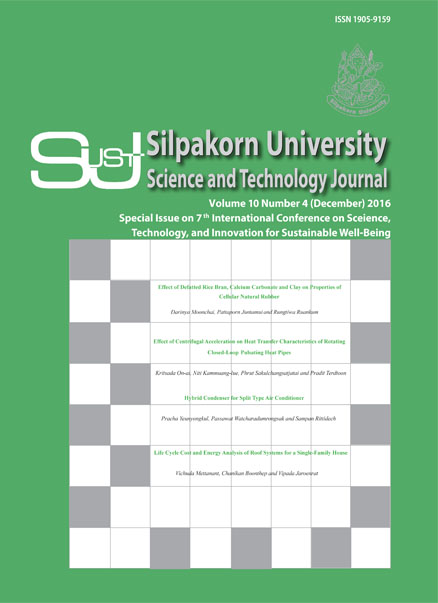Effect of Centrifugal Acceleration on Heat Transfer Characteristics of Rotating Closed-Loop Pulsating Heat Pipes
Main Article Content
Abstract
The objective of this paper is to qualitatively study the effect of centrifugal acceleration on heat transfer characteristic of a rotating closed-loop pulsating heat pipe (RCLPHP). RCLPHP can be applied to cool rotating devices, such as disc brake or steam turbine. It improves the lifetime and reduces the wear of the device. In recent studies, effects of several parameters on thermal performanceof CLPHP have been investigatede.g. inner diameter, length of evaporator section, meandering of turn and working fluid. Some researchersderivedthese parameters in dimensionless form, and then established correlation to predict thermal performance of CLPHP at specified inclination angles. Another parameter that affects rotating or moving heat pipe is centrifugal acceleration. The induced internal centrifugal acceleration of the RCLPHP affects the circulation of working fluid. When flow direction of condensate is in the same direction as the acceleration,the centrifugal acceleration is defined to be positive. In turn,thecondensate is in thecounter-flow direction to the acceleration, if centrifugal acceleration is negative. This acceleration affectsthe circulation of liquid phase. Because of heavier mass of the liquid, most of itaccumulatedat the end part of evaporator section. When the RCLPHPis heated, working fluid in this section changes from liquid to vapor phase. Then it circulates to condenser section, or another end, and condensed. When centrifugal acceleration is increased, thermal resistance decreases. The condensate can quickly circulate to evaporation sectionbecause working fluid velocityis higher than those at lower acceleration. In the future, researches to quantitatively study on the effects of centrifugal and parameters which related to the thermal performance of RCLPHP will be further conducted.
Downloads
Article Details
References
Akachi, H., Polasek, F., and Stulc, P. (1995). Pulsating heat pipe. In Proceedingsof the 5th International Heat Pipe Symposium, Melbourne, Australia.
Chareonsawan, P., Khandekar, S., Groll, M., and Terdtoon, P. (2003). Closed-loop pulsating heat pipe part A: Parametric experimental investigations. Applied Thermal Engineering, 23: 2009-2020.
Charoensawan, P., and Terdtoon, P. (2008). Themal performance of horizontal closed-loop oscillating heat pipe. Applied Thermal Engineering, 28:460-466.
Kammuang-Lue, N., Sakulchangsatjatai, P., Terdtoon, P., and Mook, D. J. (2009). Correlation to predict the maximum heat flux of a vertical closed-loop pulsating heat pipe. Heat Transfer Engineering, 30: 961-972.
Kammuang-Lue, N., Hudakorn, T., and Terdtoon, P. (2010). Establishment, verification and application of a correlation to predict the maximum heat flux of a horizontal closed-loop pulsating heat pipe. Energy Research Journal, 1: 96-103.
Khandekar, S., Chareonsawan, P., Groll, M., and Terdtoon, P. (2003). Closed-loop pulsating heat pipe part B: Visualization & semi-empirical modeling. Applied Thermal Engineering, 23: 2021-2033.
Maezawa, S., Gi, K. Y., Minamisawa, A., and Akachi, H. (1955). Thermal performance of capillary tube thermosyphon. In Proceedings of the IX International Heat Pipe Conference, Albuquerque, USA.
On-ai, K., Kammuang-lue, N., Terdtoon, P., and Sakulchangsatjatai, P. (2013). Effect of working fluid types on thermal performance of vertical closed-loop pulsating heat pipe. In Proceedings of the 5th International Conference on Science, Luang Prabang, Loa PDR.
Sriwiset, C., Kammuang-lue, N., Sakulchangsatjatai, P., and Terdtoon, P. (2013). Evaluation of optimum turn number for closed-loop pPulsating heat pipe at normal operation. In Proceedings of the 5th International Conference on Science, Luang Prabang, Loa PDR.
Waowaew, N., Terdtoon, P., Maezawa, S., Kamonpet, P., and Klongpanich, W. (2003). Correlation to predict heat transfer characteristics of a radially rotating heat pipe at vertical position. Applied Thermal Engineering, 23: 1019-1032.


